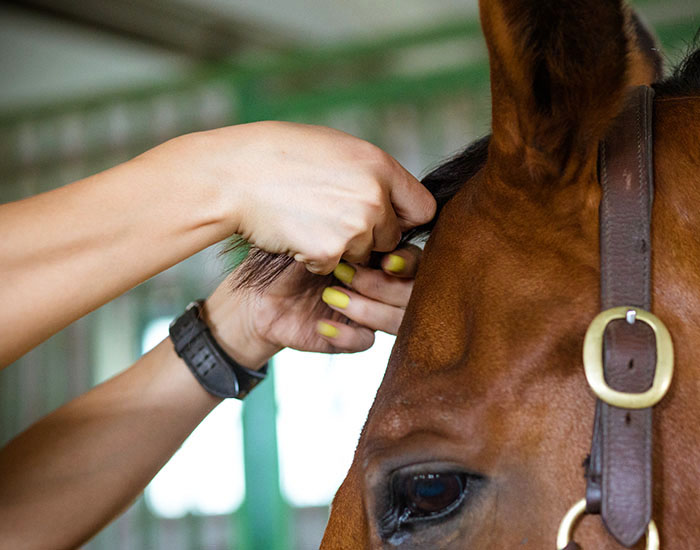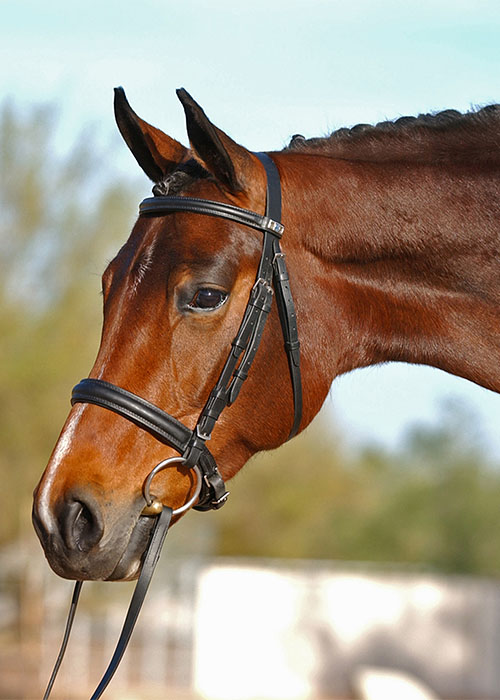
When it comes to proper turnout for hunter/jumper, dressage, or eventing competitions, a neat and tidy forelock braid is essential. Ideally, the braid will lay flat against your horse’s forehead, without impeding the fit of the bridle. In this blog post, we cover how to properly french braid a forelock for the show ring.
Necessary Supplies
Before you begin plaiting your horse’s forelock, make sure that you have the proper tools and equipment collected. To braid a forelock, you will need:
- Step stool or a grooming tote that you can stand on
- Aluminum pulling comb
- Mane spray (such as Quic Braid or Mane ‘N Tail Spray N Braid)
- Small sponge
- Scissors
- Pull through tool or braiding hook
- Yarn – cut into one 24 inch length piece (Lucky Braids Braiding Yarn is popular)
You can braid your horse’s mane and forelock in a yarn that matches their mane hair color or in a contrasting color. Generally, working hunters and hunt seat equitation mounts are braiding in matching colors while you can take more liberties with jumpers and dressage horses. If in doubt, braid in a yarn color that corresponds to your horse’s mane color. Your horse’s forelock should always be braided in the same color as your horse’s mane.
How to Braid a Forelock

When working on braiding a forelock, it is best to work quickly and efficiently in order to stay safe and keep your horse happy. Make sure that you have everything you need within arm’s reach, preferably in a pocket or hanging from a belt loop. Then, it’s time to get started.
- Begin by preparing your horse’s forelock and bridle path for the braiding process (ideally this would be done a day or two before the competition so that you can minimize the amount of time braiding your horse on the day of or late into the night before). Trim the bridle path so it is about an inch wide, but do not cut into the line of the forelock behind the ears. Then, brush your horse’s forelock forward and ensure that there are no knots in the forelock. If desired, you can shorten the forelock using a clipper blade or a pair of scissors, but many equestrians prefer to leave the forelock as natural as possible.
- To begin braiding the forelock, stand on your step stool directly in front of your horse’s head. It is important to utilize safe horse handling techniques, since this may make some horses uncomfortable or nervous. Whenever possible, have someone else hold the horse’s head while you are braiding the forelock.
- Organize the hair, pulling it toward you with your pulling comb. Using the sponge, apply the mane spray until the hair is uniformly dampened. This will help to prevent flyaway hairs from occurring (be sure to never spray the spray directly on to your horse’s head or forelock since this is likely to scare them and could be quite dangerous).
- Using your comb, section off the chunk of hair directly in front of the bridle path (about half an inch). Divide this section into three equal parts. This will be the start of your braid.
- Begin to braid, crossing the outside section over the inside portion of the braid; be sure to keep your thumb in the cross of the braid in order to maintain adequate tension.
- After you have pulled hair over from each side, you will want to begin to add hair in from the sides of the forelock. To do this, cross your section of hair over and then take a small piece from the forelock (on the same side as the cross) and add it to the braid. Taking small sections will make the braid appear neater and will make it easier to keep the braid tight.
- Continue moving down the forelock, adding in sections of hair, and keeping the braid pulled tight. Keeping your body centered with the horse’s head will keep the braid straight in the middle of the forelock.
- When you have reached the bottom of the area where the hair is actively growing from your horse’s forehead skin, incorporate the remaining hair into the braid by dividing it into three sections and adding it to the established braid.
- Keeping the braid tight, braid the for an additional inch. Then add the yarn into your horse’s forelock by folding it in half and then lying it over the outside two sections. Braid for one to two additional inches after you have added in the yarn. You do not need to braid the entire length of the forelock.
- Carefully pull the yarn away from the hair in preparation for making a knot. Holding the yarn in one hand and the braid in the other, use your finger to loop the yarn under the braid and then pull the tail of the yarn over the top of the braid and through the loop. Pull to tighten the knot.
- Use your pull-through to push through the top of the forelock, along where the hair is actively growing from your horse’s forehead skin, and down to the center of the bottom of the braid. Insert the yarn into the hook and gently it up through the top. Wrap the excess hair from the tail of the braid around the yarn as it is pulled upward. This will help to organize the hair and allows all of it to be pulled into the braid.
- It may take a bit of force, but carefully pull the yarn until the knot of the bottom of the braid is high within the French braid of the forelock.
- Divide the yarn into two pieces, then using the latch hook, pull one yarn piece through one side of the braid, and the other piece through the opposite side of the braid.
- Use two surgical knots to secure the yarn and fasten the braid. Clip the excess yarn with a pair of scissors.
- Step off the stool and admire your handiwork!
When it comes to braiding your horse’s forelock for horse shows, regular practice is important so that your hands become accustomed to the motions. To learn more about braiding forelocks and watch a step-by-step braiding tutorial, check out the video below:
A tight forelock braid accentuates your horse’s beautiful features, and it also allows the judge to focus on your performance. At The Cheshire Horse, we carry everything that you need to properly turn out your horse for the show ring. If you have any questions regarding the equine products that we carry or would like personalized recommendations based on your unique competition needs, we invite you to speak to a member of our friendly and highly trained sales staff.
